Avoiding Nightmare Cover Letters
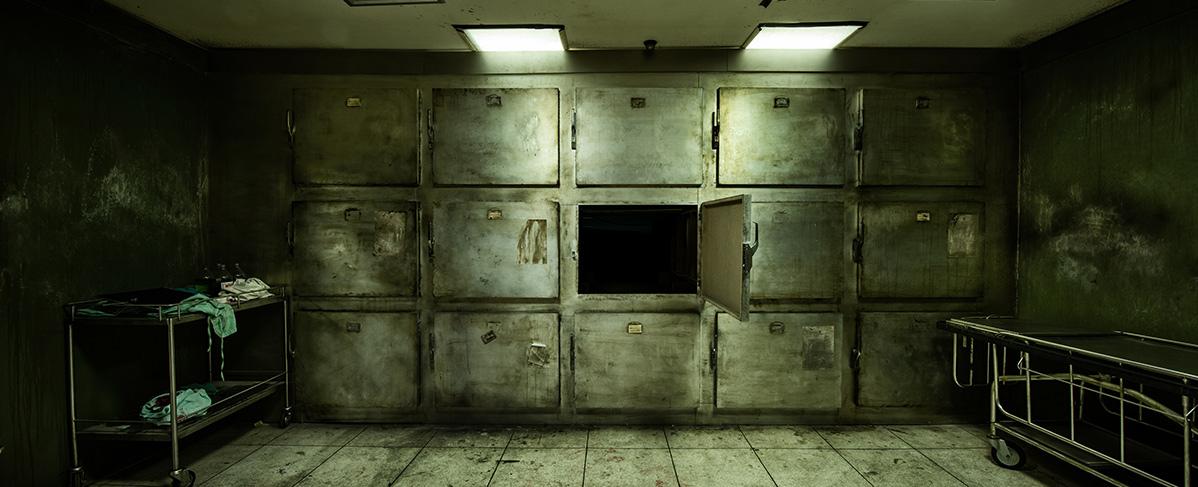
Does a trip to the morgue seem more enticing than writing another cover letter? In this article, I’ll share ways I made the process less horrifying.
Why Cover Letters Suck
I detested the process of creating a Scrum Master cover letter each time I applied for a job. After some soul searching, I determine there were five main reasons for my hatred. Let’s cover those points and the process changes I made to overcome them.
I’m Not Good at Selling
It seems to me that the main point of a cover letter is to sell yourself like a used car. Instead of new tires, we have recent certifications. I’ll rave on about my attention to detail instead of the excellent gas mileage.
The whole thing makes me feel like the smarmy salesman that sold me my first brand new car. “This trunk has a ton of room for books,” he told me, leveraging the only thing he knew about me - that I was a college student.
Unbeknownst to him, a cheesecake-filled trunk would have been more enticing than books. He didn’t know his audience. This lack of connection is also why I struggled with cover letters.
What do I know about this mysterious person who’ll read my cover letter? How will they ascertain my worth? What should I say to convince them I’m the best fit for the job?
As it happens, I have all the information I need to make this sale. No one is more familiar with my strengths than I am. I also know more about the ultimate decision-maker than my salesman knew about me. After all, they provided their list of criteria in the form of a job posting.
Eh, the job posting, you may sneer. I saw you roll your eyes.
Most job candidates approach the list of requirements from the wrong direction. Don’t view them as a list of disqualifications. Finding a candidate that ticks off all the boxes is rarer than a unicorn sighting.
It boils down to the simple matter of a match game. Which qualities do I excel at that the hiring company is also interested in?
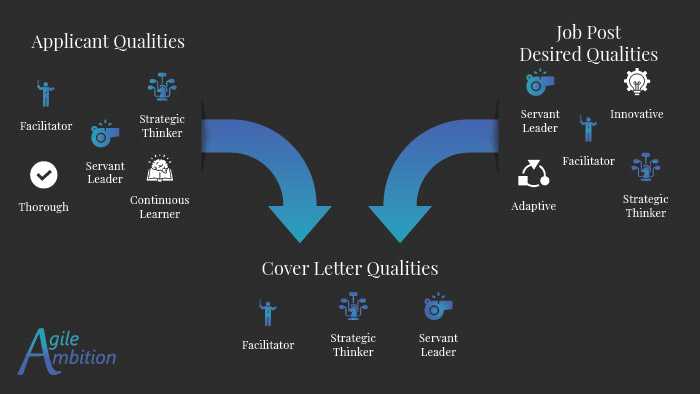
Once I had this little epiphany, my Scrum Master cover letters became much easier to write.
Potential to Burn a Bridge
Another of my struggles with crafting the perfect cover letter was precisely that goal. My definition of perfect was whatever cover letter would get me the job.
I had this fear that if I didn’t say the right thing, I’d burn a bridge and lose this opportunity forever. There are several things wrong with that mindset.
First, I had some naive belief that this was the perfect job for me. Here at this point in the process, knowing the least I’d ever know about the position, I’d already decided I wanted it.
You wouldn’t decide to marry someone without dating them first.
The second issue with my mentality was an inclination to game the system. I was never dishonest, but I was always looking for what I could say to make the organization want to hire me.

Be genuine. If the hiring company doesn’t like you for who you are, there are plenty of other fish in the sea.
Cover Letters are Time Consuming
In the beginning, it took me hours to write a cover letter. I squandered much of that time lost in research.
I believed that this boundless research would enable me to custom tailor the cover letter. I was also trying to validate my interest in the organization.
One day I happened upon an interesting stat. According to Zip Job, ten percent is an average interview to application ratio. That means nine out of ten applications submitted will not result in an interview.
Any effort put into submitting applications that won’t result in an interview is a waste of time.
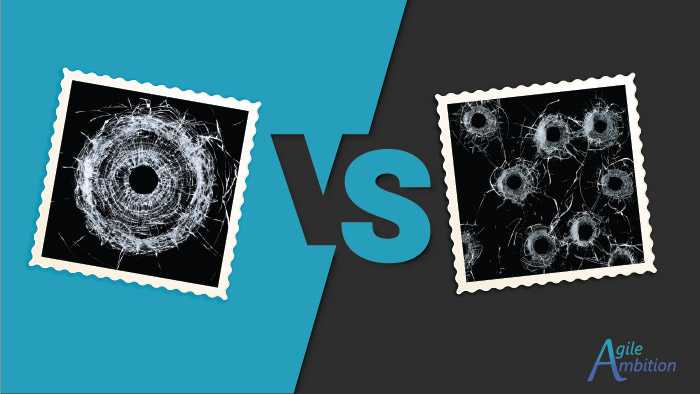
With this new theory, I began to apply for any job that I couldn’t eliminate based on a cursory review of the job listing. I then allowed the various organizations to do the filtering for me. If a company offered me an interview, I could do any necessary research at that point. Eliminating the extraneous research resulted in a savings of several hours.
Souless Templates
The easiest solution to the cover letter issue is to use a template. I avoided this for the longest time because I worried it would come off as flat and uninteresting.
I spoke with some friends about writing cover letters and got a few ideas from them (thanks if you’re reading this). I also incorporated some elements from a course I was taking on presentations.
Inspired by Jason Teteak’s Rule the Room, I tried to work a story into my cover letter. I wanted something interesting to hook the reader in the beginning. In the end, I wanted to reveal the outcome and tie the whole letter together.
This story which creates the endcaps of the letter, is position agnostic. It highlights a skill that would be applicable for every role I applied to. This prevents me from needed to tweak those parts of the cover letter for each application.
Starting from Scratch
Given my original aversion to templates, I created each cover letter from scratch. Starting with a blank page was rooted in a misguided attempt to customize each cover letter to the role. As if leftover remnants from previous attempts could somehow taint the current draft. How asinine.
Stephen King has some advice on the blank page in his book, On Writing.
“You must not come lightly to the blank page.”
-Stephen King
I needed a better game plan for my approach to writing the body of my Scrum Master cover letters. I was showing up dull-eyed and slack-jawed hoping magic would happen. I needed to come to the computer better prepared to battle the blank screen.
Around this same time, I began reading the ‘Interview Master Guide’ from The Interview Guys. These guys propose that every requirement or skill on a job posting boils down to a “quality.”
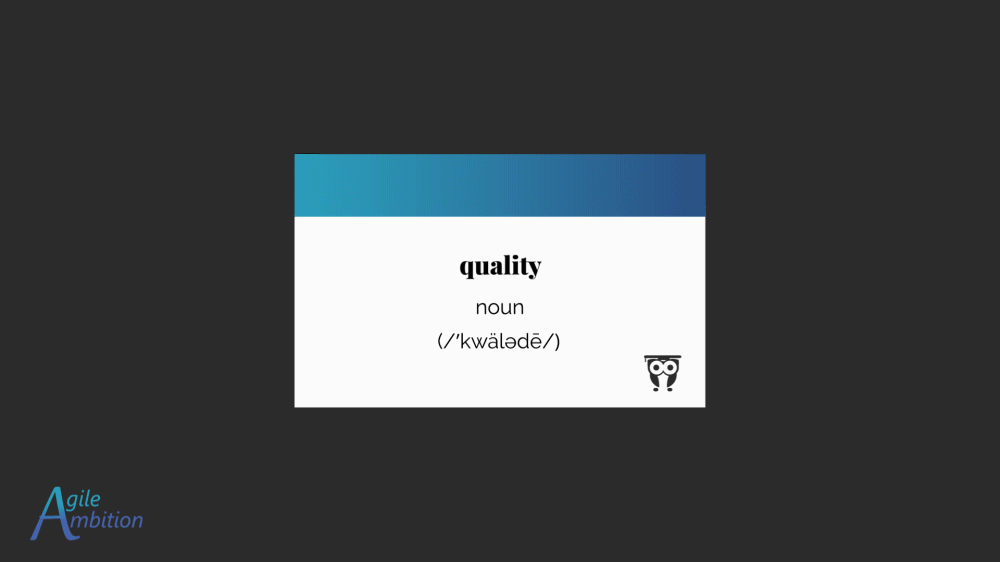
I experienced a paradigm shift. My method of creating cover letters to this point revolved around these qualities, but I wasn’t thinking about them in this way. I would try to find applicable skills and emphasis them in the cover letter.
Now, I started to think of my skills as qualities. Then, it became apparent that my qualities were static at a given moment. It is also possible to discuss them in an atomic way. For instance, I can tell you about my skill in removing impediments. Understanding that skill is not dependent on knowing anything of my other qualities.
Also, my qualities are my own. They are agnostic of the organization for which I am employed. My communication skills apply the same at Facebook as they do at Frank’s Hotdog Shoppe.
This line of thought led me to create a dictionary of qualities. For each quality I identified, I wrote a succinct paragraph. In these paragraphs, I demonstrated the application and resulting benefit of each quality.
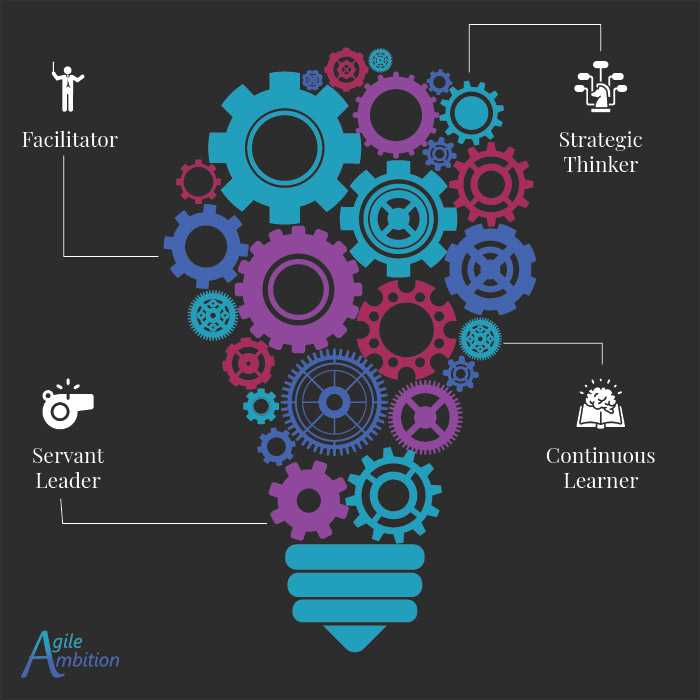
These individual quality paragraphs provided many benefits over my previous process. Developing a single section was much more manageable than the magnum opus I attempted before. The qualities were also reusable. I could cut the paragraphs from the dictionary and paste them into a new cover letter. Since I was reusing the exact wording, I could improve my writing with each use.
I followed a YAGNI (you ain’t gonna need it) approach to develop my quality paragraphs. I avoided defining all the qualities of a Scrum Master (or of myself) upfront. Instead, I focused on the specific jobs I applied for. I distilled each down to the top three qualities they wanted and I possessed. If I’d already written about that quality, I reused what I had. Otherwise, I’d write a new entry in my quality dictionary. When I reused an existing quality, I would proofread it and make improvements over time.
Putting it all Together: The Scrum Master Cover Letter Template
I ended up with a template roughly structured like this:
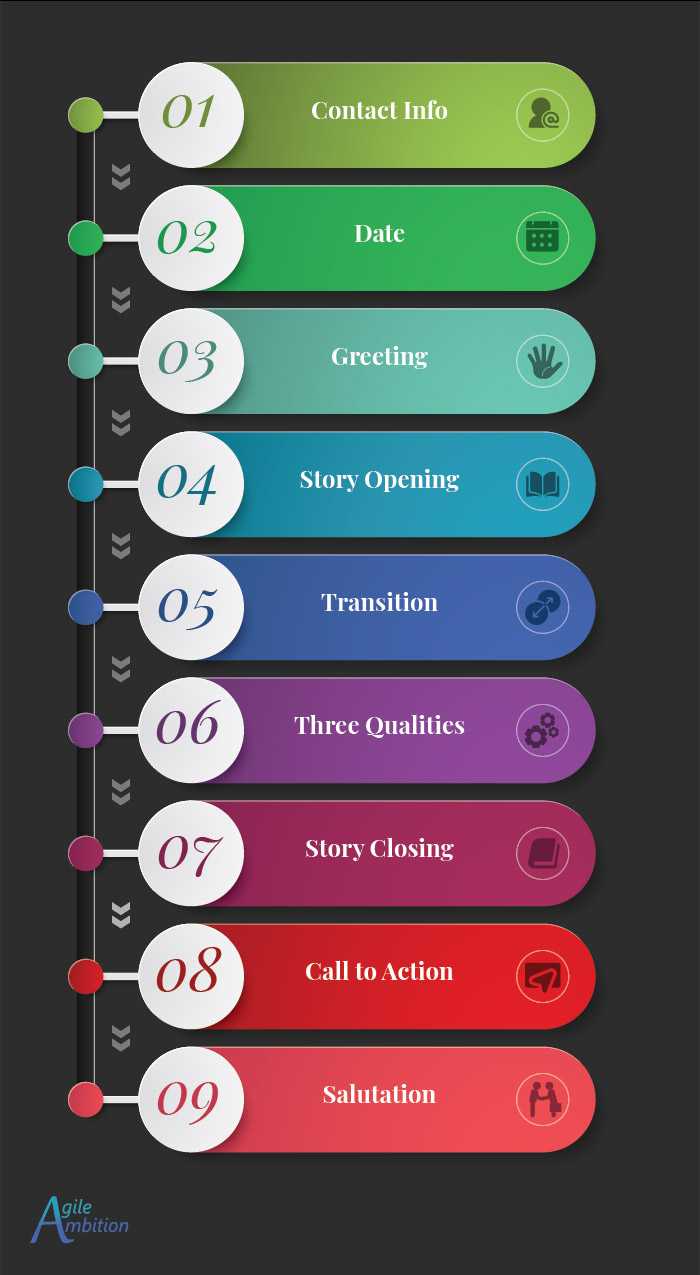
The template retains the standard format of a letter, starting with contact information. I left a date to help give it the vibe of a recently created document. I stuck to a generic greeting, which I’ll elaborate on in a moment. From there, you can see the quality paragraphs sandwiched in the opening and closing story. There is a transition paragraph between the opening story and skill paragraphs. This transition helps make the jump into my skills less jarring. The last paragraph is a call to action. Finally, we have the salutation.
Greetings
I open the letter with a simple “Dear Hiring Team.” This generic method is contra to popular opinion. Much of my research indicated that you should endeavor to specify the name of the hiring manager. There are three reasons I avoided that approach.
First, it can take a tremendous amount of time to identify the hiring manager’s name. There are various sleuthing and social stalking tactics to find this information. However, more than a few of these methods were dubious regarding their effectiveness.
Second, the risk of getting it wrong seems to outweigh the reward of getting it right. Let’s say you do your sleuthing, and you decide to address the letter to Hermione. When Hermione reads the document, she might find it charming that you could deduce her name. If it’s actually Harry who reads your letter, the incorrect address will be irritating. The risk of an irritated Harry outweighs the reward of a charmed Hermione, in my book.
Last, I find it creepy when someone refers to me by my first name when I’ve never met them. It comes off as pretentious. Unsettling the reader is the last thing I want to do in a cover letter.
Story Wrapper
I chose to tell a story that highlighted some qualities applicable to any job I’d apply for. I hope that the story will alleviate the monotony of a typical cover letter.
I tried for an exciting opening with a bit of a cliffhanger that gets resolved in the next to last paragraph. Book that tie the closing back to the beginning bring me joy. I try to implement that same sense of closure in my cover letters.
Early in my career, my boss asked me to adjust an estimate to align with an arbitrary date selected by executive leadership. Flummoxed by this request, I set out to discover a better alternative to forecasting delivery dates. My research led to a series of events culminating in a boardroom where I sat opposite a very straight-laced executive director known for his command and control mindset, preparing to explain the concept of story points.
Even early in my career, I successfully applied my teaching and persuasion skills to demonstrate the benefits of story points to executive leadership. The resulting process change increased our forecasts’ accuracy and transparency, eliminated the waste of conforming hourly estimates to arbitrary deadlines, and alleviated the unnecessary pressures resulting from deadline-driven development.
A literary genius I am not - something you know if you read this blog. I can’t say that it all came together exactly as grand as I’d planned, but that’s what I was going for. Love it or hate it, that’s what I went with.
Position Specific Qualities
I added a transition paragraph between the opening and quality paragraphs. This transition also includes a smidgeon of customization toward the hiring organization.
In hindsight, it’s easy for me to mark this experience as the first step in my agile journey. Along this path of continuous learning, I’ve developed skills that I believe make me a good fit for the [role] position at [company].
My three atomic quality-based paragraphs come next. I try to keep these paragraphs to four sentences or less. To provide more substance, I give an example of leveraging each quality. Specifying the employer and their earned benefit lends the quality authenticity.
With [Company Name], I served as Scrum Master of four separate teams composed of members spanning three companies and four timezones. I became adept at recognizing confusion and used facilitation techniques to lead the team to a shared understanding. The improved team clarity increased throughput by reducing rework and repeated meetings.
Call to Action
My last paragraph is a very subtle call to action. I express my interest in the position and show gratitude for the time spent reading the cover letter.
I’d be grateful for an opportunity to demonstrate how my skills and experience make me an excellent fit for the [position] role and learn more about [Company Name]. Thank you for taking the time to review my application.
A tad more customization occurs here as well. I wanted to include the name of the company and position in more than one location. These changes are simple to make and reduce the carbon copy vibe.
Salutations
Most salutations sound like frippery to me. Sincerely yours? That sounds like something I’d say to my heart-mate, not a future employer. What if we drop the ‘yours’ and go with ‘Sincerely?’ It feels like I’m trying to differentiate myself from all the insincere folk.
After trying several, I landed on “Cheers.” It’s generally used more in the UK than the US, but it feels bright and airy. It also adds a slight bit of quirk, which I rather enjoy.
Works Consulted
- Rule the Room: A Unique, Practical and Comprehensive Guide to Making a Successful Presentation
- On Writing: A Memoir of the Craft
- Interview Guys
- StrengthsFinder 2.0
- The Ideal Application to Response Rate (+5 Tips for 75% More)
TLDR
Cover letters don’t have to be a nightmare. Find ways to trim waste and let your best cover letter process emerge over time. Limit unnecessary upfront research, maximize reusability, and incrementally improve with each application you submit.
Share
Table Of Contents
Fuel an Idea
Every week, I break down complex ideas, strip away the fluff, and give you experiments to turn knowledge into skills.
If that’s worth a coffee, consider fueling the next big insight.
No pressure. No guilt trips. Just impact.
Buy Me a CoffeeRelated Posts
Quick Links
Legal Stuff

